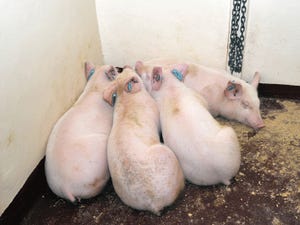Prevent lameness from causing sows to walk off your farm
Sow claw trimming shows benefits for pig performance.
January 4, 2018

Your sows’ feet matter. As a leading cause of sow removal, lameness impacts feed intake and reproductive performance. Don’t let lameness be the reason your sows have to leave your farm.
Results from a recent study measuring the impact of trimming long claws for second- and third-parity sows, show sows with trimmed feet produced 0.3 more pigs born alive per litter than non-trimmed sows when averaged across two farrowing events.1 By trimming sows’ toes, you can improve productivity on your farm.
“While treatment of long toes in pigs is effective, prevention is a more economical approach,” says Zachary Rambo, PhD., swine research nutritionist for Zinpro Corp. “We’ve seen reductions in long toes with the inclusion of the right minerals in the diet and maintaining an appropriate sow claw trimming routine. The decision to implement trimming largely depends on the baseline prevalence of long toes and the availability of labor.”
Claw trimming can help sows experiencing lameness caused by unequal weight bearing on overgrown toes and dew claws. Trimming the claw to restore it to its normal condition helps control claw horn overgrowth and limits lameness. Also, correcting existing claw lesions may further benefit sow performance.
With a four-step claw trimming technique, you can help ensure the well-being and productivity of your pigs.

Step 1: Trim the toes
The ideal toe length for a sow is about 50 millimeters. Use nippers to shorten a toe (several increments may be necessary). After each cut, inspect the toe to determine if another can be safely done. You may have cases in which a sow has one overgrown toe and one short, stunted toe. With this type of foot, it may be impossible to match the length of the short toe.
Step 2: Trim dew claws
“Overgrown dew claws are prone to injury and can interfere with normal locomotion of the sow,” says Rambo. “You want your pigs’ dew claw horn to be approximately 20 millimeters long, or even with the coronary band.”
Just like trimming the toes, use your nippers to reduce dew claw length in increments until it is at a desirable length. Then use an angle grinder to round off the end of the dew claws.
Use a grinder to remove loose and undermined horn tissue. Do this until the reattachment of the horn with the underlying tissues become evident. This procedure must be done with care to avoid damaging the corium and causing bleeding.
“Make sure not to draw blood from the claw when trimming,” Rambo says. “If you draw blood, you’re trimming too aggressively and have penetrated the corium. It is better to leave a little extra horn than to remove too much.”
Step 3: Balance the sole and heel
You’ll want to use a grinder to reduce the sole depth. Your goal is to have a flat and level sole area across both claws for functional weight bearing of the foot.
“It is common for the outside, or lateral, claw to be more overgrown than the inside, or medial, claw. The lateral likely will need more sole horn removed,” says Rambo. “The medial claw often only needs flattening, with minimal sole or horn removal.”
If the heel of the pig is overgrown, remove soft tissue with the grinder. The heel should not be trimmed all the way flat to match the sole, as it acts as a “first impact” shock absorber when the sow walks.
Step 4: Straighten the dorsal wall
Toe overgrowth often curves or buckles the dorsal wall, making it concave. The wall should be straight from the coronary band to the bearing surface. Use the angle grinder to straighten the wall by removing excess wall horn below the area where the buckling occurs.
Preventing lameness can help keep your operation profitable by keeping sows in your herd longer. Keep long claws at bay with the right nutrition and with proactive foot trimming.
Swine producers, veterinarians and nutritionists can learn more about sow nutritional needs and the Feeding for 30 Program by visiting Feedingfor30.com or Facebook.com/Feedingfor30.
1 A. DeDecker, X Martinex, E. Benitez, T. Coffey, J. Torrison, Z. Rambo, M. Wilson, and M. Parsley. 2016. Effect of trimming long toes of sows on longevity, productivity, and economic return. IPVS, p 153.
Source: Filament
You May Also Like



